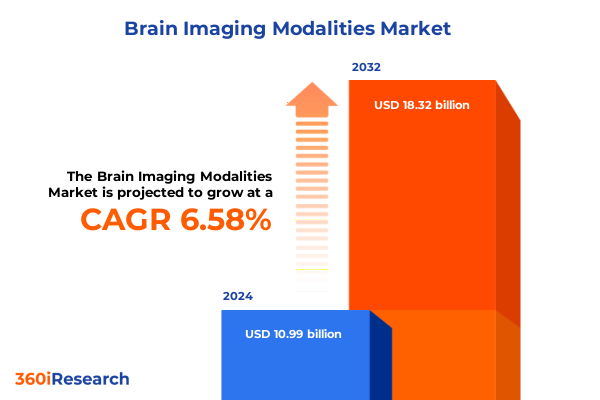The Brain Imaging Modalities Market size was estimated at USD 10.99 billion in 2024 and expected to reach USD 11.71 billion in 2025, at a CAGR of 6.58% to reach USD 18.32 billion by 2032.

Navigating the Evolving Landscape of Brain Imaging Modalities and Their Impact on Clinical Practice, Research, and Technological Innovation
Neurological conditions are now the leading cause of ill health and disability worldwide, affecting more than one third of the global population in 2021 and driving a surge in demand for advanced diagnostic tools to better understand, monitor, and treat these diseases. The rapid rise in prevalence of disorders such as stroke, Alzheimer's disease, and traumatic brain injury underscores the critical importance of robust imaging platforms that can detect subtle structural and functional abnormalities with speed and precision.
Exploring the Transformative Technological and Scientific Shifts Revolutionizing Brain Imaging Techniques Across Diagnostics Research and Therapeutic Applications
Artificial intelligence and machine learning have emerged as cornerstones of brain imaging innovation, enabling automated detection of pathological features and personalized scan protocols that adapt in real time to patient-specific anatomy and risk profiles. This convergence of computational power and imaging data is not only accelerating diagnostic workflows but also empowering clinicians to make more informed decisions based on comprehensive, high-dimensional analyses.
Assessing the Cumulative Effects of 2025 United States Tariff Policies on Brain Imaging Equipment Supply Chains Costs and Innovation Pathways
Since early 2025, the United States has implemented a series of tariffs on imports of medical equipment, imposing baseline levies of 10 percent and escalating duties on goods from key trading partners, including China and the European Union. The 25 percent tariffs on steel and aluminum components further compound costs for manufacturers integrating these materials into high-precision instruments. As a result, hospitals now face an incremental cost of $100,000 to $200,000 on advanced computed tomography and magnetic resonance imaging systems, prompting capital expenditure deferrals and renegotiations of procurement contracts.
Uncovering Critical Segmentation Insights Illuminating How Modality Application and End User Dynamics Shape the Brain Imaging Market Landscape
Analyzing the brain imaging market by modality reveals that computed tomography advances, such as cone beam CT, are securing stronger clinical adoption in emergency and intraoperative settings, while conventional CT continues to anchor stroke and trauma protocols. In magnetic resonance imaging, diffusion and functional MRI are driving research breakthroughs in connectivity mapping, even as structural and angiography sequences remain indispensable for high-resolution anatomical and vascular assessments. Within optical imaging, functional near-infrared spectroscopy and optical coherence tomography are expanding noninvasive monitoring capabilities in neonatal and neurovascular care. Positron emission tomography subtypes targeting amyloid, dopamine, and FDG uptake are refining disease staging in neurodegenerative conditions, and single photon emission computed tomography focusing on dopamine transporter imaging enhances diagnostic accuracy for movement disorders. Ultrasound imaging, through biomicroscopy and transcranial Doppler, continues to support portable, cost-effective neurovascular evaluation in both acute and ambulatory care.
This comprehensive research report categorizes the Brain Imaging Modalities market into clearly defined segments, providing a detailed analysis of emerging trends and precise revenue forecasts to support strategic decision-making.
- Modality
- Application
- End User
Analyzing Distinct Regional Opportunities and Challenges Across the Americas Europe Middle East Africa and Asia Pacific Brain Imaging Sectors
Regionally, the Americas are characterized by large academic medical centers leading research in hybrid imaging and AI-driven platforms, coupled with robust reimbursement frameworks that accelerate technology adoption. In Europe, Middle East, and Africa, diverse regulatory environments and variable healthcare infrastructure drive a tiered uptake of imaging systems, where leading economies invest in high-field MRI and PET while emerging markets prioritize cost-effective CT and ultrasound solutions. The Asia-Pacific region is witnessing rapid expansion of research institutes and large hospital networks that integrate optical and portable imaging modalities, supported by local manufacturing initiatives that mitigate supply chain risks and align with evolving tariff landscapes.
This comprehensive research report examines key regions that drive the evolution of the Brain Imaging Modalities market, offering deep insights into regional trends, growth factors, and industry developments that are influencing market performance.
- Americas
- Europe, Middle East & Africa
- Asia-Pacific
Revealing Strategic Moves Competitive Strengths and Innovation Trajectories of Leading Brain Imaging Technology Companies in a Rapidly Evolving Market
Leading industry participants are forging ahead with differentiated strategies to capture key segments. GE HealthCare is accelerating local-for-local manufacturing initiatives across its global network to mitigate tariff impacts, simultaneously enhancing its digital imaging portfolio with cloud-native solutions to support remote diagnostics. Siemens Healthineers continues to invest in photon-counting CT and AI-augmented workflow modules, aiming to elevate image quality and reduce radiation exposure, while navigating high import duties by lobbying for sector-specific exemptions. Philips Healthcare is focusing on margin preservation through supply chain de-risking and tariff mitigation programs, channeling savings into R&D for hybrid PET/MRI and advanced ultrasound platforms. Emerging vendors are targeting niche applications in functional MRI analytics and portable optical imaging, leveraging software differentiation and collaborative partnerships with academic institutions.
This comprehensive research report delivers an in-depth overview of the principal market players in the Brain Imaging Modalities market, evaluating their market share, strategic initiatives, and competitive positioning to illuminate the factors shaping the competitive landscape.
- Siemens Healthineers AG
- General Electric Company
- Koninklijke Philips N.V.
- Canon Inc.
- Hitachi Ltd.
- Fujifilm Holdings Corporation
- Shimadzu Corporation
- Neusoft Medical Systems Co., Ltd.
- Samsung Electronics Co., Ltd.
- Bruker Corporation
Formulating Actionable Recommendations to Drive Resilience Innovation and Growth for Industry Leaders in the Brain Imaging Domain
To build resilience against escalating trade barriers and geopolitical volatility, industry leaders should accelerate supply chain diversification by expanding assembly and component sourcing in tariff-free territories. Investment in modular manufacturing platforms and digital twins can facilitate rapid reconfiguration of production workflows and optimize inventory buffers. Companies must also deepen collaborations with regulatory bodies to secure duty-exempt status for life-critical devices and advocate for harmonized global standards that streamline market entry. Moreover, prioritizing strategic alliances with AI and software partners will enhance modality interoperability and unlock new service-based revenue streams through predictive maintenance and remote monitoring offerings.
Detailing the Comprehensive Research Methodology Underpinning Rigorous Data Collection Analysis and Validation for Brain Imaging Market Insights
This research combines primary interviews with key opinion leaders, including radiologists, neuroscientists, supply chain executives, and policy analysts, alongside secondary data drawn from peer-reviewed publications, trade associations, and customs filings. Quantitative analysis of tariff rates, manufacturing footprints, and procurement cycles was conducted using proprietary models validated against public financial disclosures. Qualitative insights were triangulated through expert panels and scenario-planning workshops to ensure robustness and real-world applicability. Each segmentation framework was stress-tested through sensitivity analyses, and findings were corroborated by in-market intelligence gathered from regional partners to capture local regulatory and reimbursement nuances.
This section provides a structured overview of the report, outlining key chapters and topics covered for easy reference in our Brain Imaging Modalities market comprehensive research report.
- Preface
- Research Methodology
- Executive Summary
- Market Overview
- Market Insights
- Cumulative Impact of United States Tariffs 2025
- Cumulative Impact of Artificial Intelligence 2025
- Brain Imaging Modalities Market, by Modality
- Brain Imaging Modalities Market, by Application
- Brain Imaging Modalities Market, by End User
- Brain Imaging Modalities Market, by Region
- Brain Imaging Modalities Market, by Group
- Brain Imaging Modalities Market, by Country
- Competitive Landscape
- List of Figures [Total: 26]
- List of Tables [Total: 1215 ]
Concluding Reflections on the Evolution Challenges and Strategic Imperations Shaping the Future of Brain Imaging Modalities in Healthcare and Research
The landscape of brain imaging modalities is being reshaped by converging drivers: the escalating global burden of neurological disorders, rapid advances in AI and hybrid imaging, and mounting supply chain challenges fueled by new tariff regimes. Stakeholders across the spectrum-from modality developers and healthcare providers to academic researchers and policymakers-must navigate these complexities with a cohesive strategy that aligns technological innovation with regulatory and commercial realities. By leveraging the insights outlined herein, decision-makers can position their organizations to deliver precise, timely, and cost-effective brain imaging solutions that address both current demands and emerging opportunities.
Engage with Associate Director Ketan Rohom to Unlock In-Depth Market Research Insights and Propel Strategic Decision Making in Brain Imaging Modalities
To further explore the detailed analysis and data-driven insights contained within our comprehensive market research report on brain imaging modalities, we invite you to contact Associate Director Ketan Rohom directly. By engaging with Ketan Rohom, you will gain tailored guidance on the most relevant findings to inform your strategic planning, unlock competitive intelligence, and identify high-value opportunities in modality development, regulatory navigation, and supply chain optimization. Initiating a conversation today will ensure your organization secures the knowledge and foresight needed to excel in this dynamic landscape of brain imaging innovation and market evolution.

- How big is the Brain Imaging Modalities Market?
- What is the Brain Imaging Modalities Market growth?
- When do I get the report?
- In what format does this report get delivered to me?
- How long has 360iResearch been around?
- What if I have a question about your reports?
- Can I share this report with my team?
- Can I use your research in my presentation?




